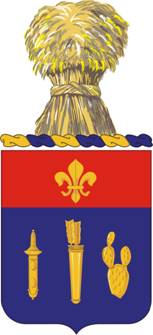The 200th Coast Artillery (AA) (200 CA) was a United States Army unit during the first half of World War II. Today descendant elements serve with the New Mexico Army National Guard as the 200th Infantry.

The 34th Infantry Division is an infantry division of the United States Army, part of the National Guard, that participated in World War I, World War II and multiple current conflicts. It was the first American division deployed to Europe in World War II, where it fought with great distinction in the Italian Campaign.

The Minnesota Army National Guard, along with the Minnesota Air National Guard, is an element of the Minnesota National Guard. The Constitution of the United States specifically charges the National Guard with dual federal and state missions. In fact, the National Guard is the only United States military force empowered to function in a state status. Those functions range from limited actions during non-emergency situations to full scale law enforcement of martial law when local law enforcement officials can no longer maintain civil control. The National Guard may be called into federal service in response to a call by the President or Congress.

The 112th Infantry Regiment, also known as the Sixteenth Pennsylvania, is a unit in the Pennsylvania National Guard which can trace its lineage back to before the American Civil War.

The 194th Armored Brigade is a separate brigade of the US Army. All armor, cavalry, and armor and cavalry mechanic soldiers, and Marines in equivalent specialties, are trained by the 194th under the armor component of the Maneuver Center of Excellence at Fort Moore, Georgia, where the 194th has been garrisoned since 2012.

The 108th Cavalry Regiment is a cavalry regiment of the Georgia and Louisiana Army National Guards of the United States Army.

The 106th Cavalry Regiment was a mechanized cavalry unit of the United States Army in World War II recognized for its outstanding action. The group was organized in 1921 as part of the Illinois National Guard and during the Spanish–American War and World War I was known as the 1st Regiment Illinois Volunteer Cavalry. It underwent a number of reorganizations before World War II. Like other Guard units during the inter-war years, the 106th held weekly or monthly drills and yearly training. Readiness for war in 1940 led to the mechanization of the unit and induction into federal service at Camp Livingston, Louisiana on 25 November 1940.

The 116th Cavalry Brigade Combat Team is the largest formation of the Idaho Army National Guard. It is headquartered at Gowen Field, Boise, Idaho. It has been reorganized into an Armored Brigade Combat Team (ABCT) but remains the only unit to be designated a "Cavalry Brigade Combat Team" by special appointment of the US Army. The 116th Cavalry Brigade Combat Team has units located throughout Idaho, Montana, Oregon, and Nevada. It was reorganized into a heavy armor brigade in 1989. Often referred to as the Snake River Brigade and formerly known as the 116th Armored Cavalry Regiment, the unit includes about 3,000 citizen-soldiers from Idaho.

The 107th Cavalry Regiment, Ohio Army National Guard, is a parent regiment under the U.S. Army Regimental System, with headquarters at Hamilton, Ohio. It currently consists of the 2nd Squadron, 107th Cavalry Regiment, part of the 37th Infantry Brigade Combat Team (BUCKEYE), Ohio National Guard located throughout southwest Ohio.

The 133rd Field Artillery Regiment is a parent field artillery regiment of the United States Army National Guard. It is currently represented in the Texas Army National Guard by the 1st, 3rd, and 4th Battalions.

The 300th Field Artillery Regiment is a Field Artillery regiment of the United States Army.

The 102nd Cavalry Regiment is a cavalry regiment of the United States Army first established in 1921. It has seen service in the Second World War, including in Normandy and at the Battle of the Bulge, in Iraq 2008–2009, in Jordan and Somalia in 2019, plus many exercises and Hurricane Sandy and Hurricane Maria relief. Its tradition of service is carried on today by the 1st Squadron 102nd Cavalry Regiment.

The Tennessee Army National Guard is a component of the United States Army and the United States National Guard. It is administered by the Tennessee Military Department. National coordination of various state National Guard units are maintained through the National Guard Bureau.
The 203rd Engineer Battalion is a combat engineer battalion of the Missouri Army National Guard.

The 1st Armored Brigade Combat Team, 34th Infantry Division is an Armored Brigade Combat Team of the Minnesota Army National Guard. It is part of the 34th Infantry Division.

The 2nd Infantry Brigade Combat Team, 34th Infantry Division is an Iowa Army National Guard unit headquartered in Boone, Iowa.

The 303rd Cavalry Regiment is a United States cavalry regiment, currently represented in the Washington Army National Guard by the 1st Squadron, 303rd Cavalry, headquartered at Vancouver, Washington, part of the 96th Troop Command. It incorporates the lineage of the 303rd Cavalry, 303rd Armor, and 803rd Armor Regiments of the Washington Army National Guard.
Troop E,256th Cavalry was the armored cavalry reconnaissance troop of the 256th Infantry Brigade of the Louisiana Army National Guard from 1967 to 1995. It was the only unit assigned to the 256th Cavalry parent regiment under the Combat Arms Regimental System, which carried over to the replacement United States Army Regimental System.

The 125th Field Artillery Regiment is a field artillery regiment of the Minnesota Army National Guard. The regiment's 1st Battalion is the 155 mm, self-propelled cannon battalion assigned to the 1st Armored Brigade Combat Team, 34th Infantry Division.
















